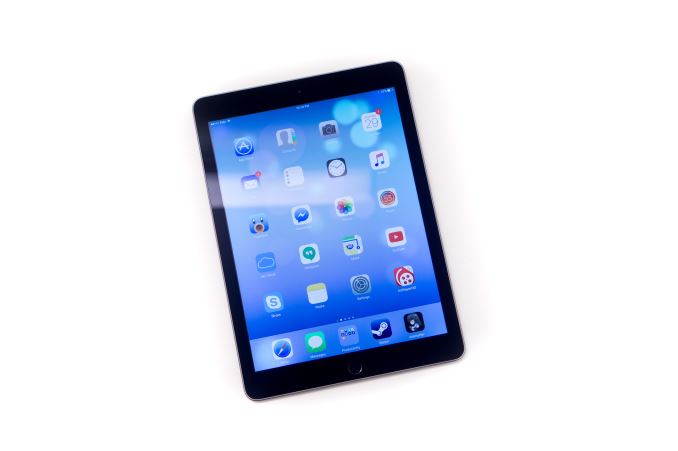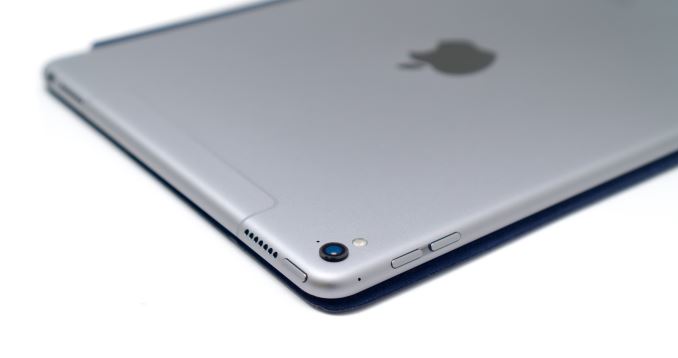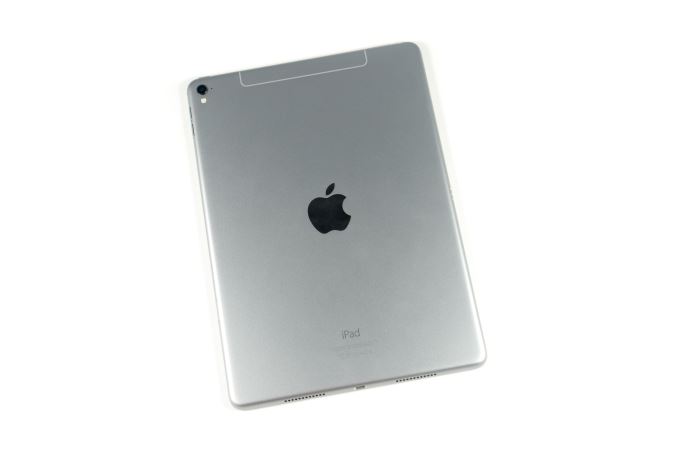The 9.7" iPad Pro Review
by Brandon Chester on June 1, 2016 9:00 AM EST
In late 2015 Apple launched a tablet that they called the iPad Pro. It had been rumored for quite some time, and it had a number of features that differentiated it from other iPads. The most notable was its 12.9" display, which has a width equal to the height of Apple's 9.7" iPads, allowing it to use two essentially full sized iPad applications at the same time in a split screen view. In addition to its massive display, the iPad Pro came with two accessories that had not existed for any prior iPad. It seemed that in Apple's eyes the Apple Pencil and the Smart Keyboard really defined what made the iPad Pro worthy of the "Pro" name.
Meanwhile, the launch of the iPad Pro came and went, and there was no news of a successor to Apple's iPad Air 2, which had just turned one year old. I thought that this move may have had to do with Apple not facing much competition in the tablet market. On the other hand, with iPad sales down it wouldn't generate much excitement to keep selling the same tablet for a second year.
After the launch of the iPad Pro the rumor mill continued to churn out new info, and there were whispers of a so called "iPad Air 3" coming in early 2016. Later, the story became that Apple was actually planning another iPad Pro to take the place of the iPad Air 2 as Apple's flagship 9.7" iPad. In the end it turned out that Apple did exactly that, and along with bringing the specs of the larger iPad Pro to a smaller size, the smaller iPad Pro comes with some surprises of its own. Below you can view the current state of the iPad line now that Apple has two devices called the iPad Pro.
| Apple iPad Family | |||
|
|
Apple iPad Air 2 | Apple iPad Pro 9.7" | Apple iPad Pro 12.9" |
| SoC | Apple A8X 3 x Apple Typhoon @ 1.5GHz |
Apple A9X 2 x Apple Twister @ ~2.2GHz |
Apple A9X 2 x Apple Twister @ ~2.2GHz |
| GPU | PowerVR 8 Cluster Series6XT | PowerVR 12 Cluster Series7XT | |
| RAM | 2GB LPDDR3 | 2GB LPDDR4 | 4GB LPDDR4 |
| NAND | 16/64/128 GB | WiFi: 32 / 128 / 256 GB | |
| WiFi + Cellular: 32 / 128 / 256 GB |
WiFi + Cellular: 128 / 256 GB |
||
| Display | 9.7" 2048x1536 IPS LCD | 12.9" 2732x2048 IPS LCD | |
| Gamut | sRGB | DCI-P3 | sRGB |
| Size and Mass | 240 x 169.5 x 6.1mm 437g WiFi, 444g LTE |
305.7 x 220.6 x 6.9 mm 713g WiFi, 723g LTE |
|
| Camera | 8MP Rear-facing f/2.4, 1.1 micron |
12MP Rear-facing f/2.2, 1.22 micron |
8MP Rear-facing f/2.4, 1.1 micron |
| 1.2MP Front-facing f/2.2 | 5MP Front-facing f/2.2 | 1.2MP Front-facing f/2.2 | |
| Battery | 27.3 Wh | 27.5 Wh | 38.5 Wh |
| Launch OS | iOS 8 | iOS 9 | |
| Cellular | Category 4 LTE + GPS/GNSS in Cellular SKU | ||
| Other Connectivity | 2x2 802.11a/b/g/n/ac + BT 4.2, Apple Lightning, Smart Connector on iPad Pro | ||
| SIM | Optional NanoSIM | ||
| Current Price |
16GB: $399 |
32 GB: $599 128 GB: $749 256 GB: $899 |
32 GB: $799 128 GB: $949 256 GB: $1079 (LTE) |
The 9.7” iPad Pro has the same core industrial design that Apple’s iPads have used since the launch of the iPad Air. The back is almost entirely flat, curving up quickly near the edges and meeting the cover glass with a shiny chamfered edge. Like the 12.9” model, the 9.7” iPad Pro changes things up by moving to a four-speaker audio setup, which requires holes drilled on both the top and bottom of the chassis. Interestingly, the 9.7” iPad Pro uses asymmetrical speaker grilles, with the bottom two being larger than those of the 12.9” model, and the top being smaller. This is likely due to the more constrained space inside the chassis. As for the speakers themselves, the audio quality did seem to be a step down from the larger iPad Pro, but it’s still miles ahead of anything else that I’ve seen on a tablet of this size and a significant improvement from the iPad Air 2.
The 9.7” iPad also comes with some changes of its own. The camera now has a hump, which will undoubtedly upset those who focus heavily on the uniformity of the design. There was no good way to improve upon the iPad Air 2’s camera within a 6.1mm chassis without putting a hump, and as we’ll see later, the camera in this iPad Pro is a huge improvement over Apple’s other iPads. While the hump is there, with such a large chassis the angle it makes with a flat surface is so small that the tablet doesn’t rock back and forth when using it on a table, which is extremely important to ensure the usability of the Apple Pencil.
Apple has also changed up the antenna design. Going back to the first iPads, the cellular models have sported a plastic RF window at the top of the chassis to allow for RF propagation. With the 9.7” iPad Pro, Apple adopts a similar antenna design to that of the iPhone 6 and 6s, where the top now has a metal segment for the antenna with insulating plastic lines surrounding it.
I think this is a significant upgrade to the design of the cellular model for a couple of reasons. Aesthetically it simply looks better, as the plastic inserts weren’t color matched and so they stood out from the rest of the aluminum back cover. They also weren’t always aligned perfectly, and so at the edge between the plastic and the aluminum you could feel a noticeable seam due to the plastic being either at a higher or lower level than the chassis. The new antenna design eliminates both of these issues, and brings the 9.7” iPad Pro as close as it can get to an unbroken aluminum unibody when also having to support cellular networking.
Beyond the changes with the camera, speakers, and antenna on the cellular model, the 9.7” iPad Pro has the same design as the iPad Air 2. They share the same mass and dimensions, and as I mentioned before the core ID is the same. Whether or not Apple could improve upon the design further is up for debate, but they don’t really have any true competition in this space and so they’ve been able to maintain their design lead by making iterative improvements on the original iPad Air design. That design still works very well, and so I don’t see much reason to change things up significantly just for the sake of saying you have a new design.












144 Comments
View All Comments
UtilityMax - Friday, June 3, 2016 - link
The thick and bulky Surface Pro 4 is hardly a tablet..damianrobertjones - Tuesday, June 14, 2016 - link
I have no issues using it as a tablet and I also own an ipad mini 4.ragingfighter - Wednesday, July 13, 2016 - link
I think the surface pro line depending on how one uses it makes it a competitive choice as opposed to a new Apple tablet. Many people go for the higher-end storage of the surface tablet and that regard it's price is ridiculous when you start talking $1500 for a tablet to me at the feats the purpose for $1500 you can get yourself an amazing laptop. Still would have more memory at least by double maybe even triple and the specs will be as well if you opt for mid tier say 128 GB storage solution if you have an external hard drive plugged in because it has USB three you can save yourself a lot of money. In that regard it's a small use of what the surface provides as an option and also it's an idea of saving money that makes it viable choice. Obviously the recovery partition and the operating system take up a lot of space in comparison to something like iOS or even the android platform built in storage does take a bit of a beating because of it but if you can use everything on a portable hard drive that's plugged in the USB three and run the surface and such in the way it will make the base cost far less and much more approachable. I just think in general tablets beyond I would say $800 becomes problematic specifically because you get into an upper mid tier of what a laptop can offer you for $800 and beyond and you get a lot still you can still have a decently portable laptop with a decent amount of power. Laptops though in this price range and below take a hit in quality and the most important aspect and that is the screen usually this price point or below have very crappy screens the color and their sharpness and infidelity are really not phenomenally up there. When you get in the laptops beyond $1000 point you start getting sharper queen or technology implemented into them. I feel it is important when it comes to a comparison of options out to complete a task. It comes down to really what is cost-effective for your workflow how much you need portability and how much of a solution a tablet aspiring to be a laptop killer a replacement can become Closest tablet to achieve such your feat is the Microsoft surface.ragingfighter - Wednesday, July 13, 2016 - link
Though I am a Mac user I must admit that in regards to any kind of a portable keyboard Apple they dropped the ball when I came to the iPad keyboard. It is a step behind Microsoft smart cover keyboard one because it's not backlit but also because of the way out the bun travel is smaller and the buttons are smaller not necessarily a favorite for everybody. The biggest design thing that I think Apple completely messed and I have to give kudos to Microsoft is the built in stand. I'm not a super fan of windows though I know how to use Windows and use a Windows it is nowhere near my primary platform which is the Mac. But I have to give credit to Microsoft where credit is due the surface pro line is and where the tablet but even I have to met there are many different kiosks I have been to where the tablet has malfunctioned during time of demoing it is much more rare to see an iPad completely not work for kiosk purposes that it is for surface tablet I've seen their tablets not even turn on even with the power cord extend it to them plugged in fully lights show it is fully charged but outside of doing a direct comparison to the different pros and cons of each wall smart enough to know what fits our needs the best for me and iPad is a good tablet and it doesn't basically what I needed to and for others the Microsoft surface pro line suits their needs as well. Trust me we want to open a can of apples and Microsoft comparisons here. Just say they're equally respectable types of tablets based on their own individual merits the only reason I bring up the prior points in general are because a tablet should have a stand and not needing a case to provide such or solution is a very added and welcome bonus the people on a surface tablet. Myself I don't want to surface tablet but I will give them credit for that additionMeteor2 - Thursday, June 2, 2016 - link
I'd like to see the Pro 4 in the charts where possible, please. They are aiming at similar users. I'd love to see the Dell 7275 tested though, as it looks (and feels, after using one for an hour) in many ways better than the MS Pro.blackcrayon - Monday, June 6, 2016 - link
Why would you think a 9.7" iPad Pro is aiming at similar users as a Surface Pro 4?damianrobertjones - Tuesday, June 14, 2016 - link
The word 'pro' is being used. Blame Apple.Tikcus9666 - Saturday, June 4, 2016 - link
In the UK the ipad pro 9.7" with 128GB is priced only £100 less (or a few £, if you opt for cellular version) than the Surface Pro 4 entry level with m3, 4GB and 128GB.I think comparison is very valid, also for a "Pro" device, to be considered as a "Pro" device we need more than web benchmarks, and battery life..... until it runs photoshop, lightroom, muse, sony vegas to name a few, it aint replacing a PC for real Pro's
tipoo - Wednesday, June 1, 2016 - link
I've been curious - it has less memory bandwidth than the 12.9", but not halved, despite half the pinout width and half the DRAM capacity. Does the chip reintroduce the L3 cache? That could explain it.Ryan Smith - Wednesday, June 1, 2016 - link
No. It has half the memory bandwidth. CPU benchmarks just don't show the full effect.